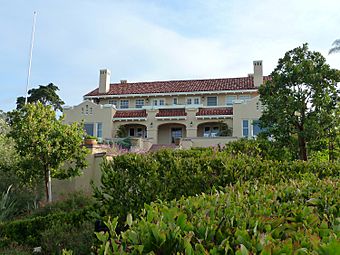Canfield–Wright House facts for kids
Quick facts for kids |
|
|
Canfield–Wright House
|
|
 |
|
| Location | 420 Avenida Primavera, Del Mar, California |
|---|---|
| Area | less than one acre |
| Built | 1910 |
| Architect | Austin, John C. |
| Architectural style | Mission/Spanish Revival |
| NRHP reference No. | 02001747 |
| Added to NRHP | May 14, 2004 |
The Canfield–Wright House, also called Wrightland or The Pink Lady, is a historic building in Del Mar, California. This private home was added to the National Register of Historic Places (NRHP) on May 14, 2004. This means it's an important place worth protecting.
Contents
Building a Dream Home
The Canfield–Wright House was built in 1910. It was made for a very successful businessman named Charles A. Canfield. He was an oil tycoon, which means he made a lot of money from oil.
Charles Canfield's Story
Charles Canfield found his first successful oil well in Los Angeles in 1892. He worked with his business partner, Edward L. Doheny. They also drilled the first oil well in Mexico. The oil they found was used to pave roads there. Their work even inspired parts of the book Oil! and the movie There Will Be Blood.
Canfield also helped the Atchison, Topeka and Santa Fe Railway switch from using coal to oil for their trains. He used his wealth to invest in land. He helped create famous places like Beverly Hills, California and Del Mar. He did this with partners like Henry E. Huntington.
The House's Special Design
Charles Canfield wanted the house to be a second home. He chose a famous architect named John C. Austin. Austin also designed the Hotel Del Mar. He later designed other big buildings in Southern California. These include the Los Angeles City Hall and the Griffith Observatory.
The Canfield–Wright House was designed in the Mission and Spanish Revival styles. It also has ideas from an Italian villa. The house was built to have a great view of the Pacific Ocean.
Saving a Piece of History
Charles Canfield passed away in 1913. His family owned the house until 1923. Then, the Wright family bought it. The house was changed only a little bit over the years. Small parts were added to the main house and other buildings. A large wall was also built on the property.
The "Pink Lady" Threat
By the late 1900s, the house was being rented out. It had been painted a bright pink color, which gave it the nickname "The Pink Lady." In 2002, a builder wanted to tear down the house. They planned to replace it with a new, modern building.
This idea made local people very upset. They wanted to save the house. They worked hard to get the building added to the National Register of Historic Places. Groups like the Save Our Heritage Organisation helped them. Citizens talked to the City of Del Mar leaders. They pushed for rules to protect old buildings. This delayed the permit to tear down the house.
A New Beginning
Within six months, a new owner stepped forward. This owner was a builder who lived nearby. They bought the property and decided to restore it. Their plans followed rules for protecting historic buildings. The home was carefully restored over four years, from 2004 to 2008. It is still a private home today.
See also
 In Spanish: Casa Canfield-Wright para niños
In Spanish: Casa Canfield-Wright para niños




